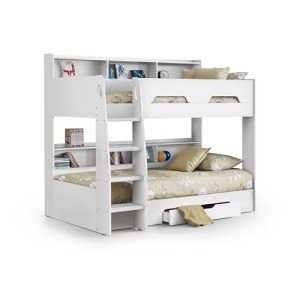The Main Problem With Bunk Beds Children's And How You Can Solve It
The Ultimate Guide to Bunk Beds for Children: Safety, Styles, and Benefits
When it pertains to styling a kid's space, parents typically deal with the double difficulty of maximizing space while ensuring convenience and functionality. Bunk beds have become a popular solution that resolves these needs, offering not simply sleeping arrangements however also contributing to a room's visual. In Bunk Bed UK carolinegonzales.top , we will dig into various aspects of children's bunk beds, focusing on their benefits, security features, styles, and factors to consider for parents contemplating this purchase.
Table of Contents
- Advantages of Bunk Beds
- Security Features to Consider
- Kinds Of Bunk Beds
- Design and Style Options
- Upkeep Tips
- Often Asked Questions (FAQs)
1. Advantages of Bunk Beds
Bunk beds offer various advantages for kids and their moms and dads. Here are some essential benefits:
Space-Efficiency: Bunk beds are an exceptional option for smaller rooms. By stacking one bed on top of another, more floor space is offered for play, storage, or research study locations.
Economical: When kids share spaces, bunk beds can decrease the need for purchasing two separate beds, thus saving money.
Promotes Social Interaction: Bunk beds can assist siblings or pals bond by sharing a space, developing chances for social advancement.
Fun Factor: The concept of sleeping “up high” includes a playful element to bedtime, making the shift to sleeping alone easier for some children.
Versatile Design: Bunk beds are available in numerous styles, colors, and designs to match any space style, permitting modification that shows the kid's character.
2. Safety Features to Consider
Security is paramount when it comes to children's furniture, specifically when it comes to bunk beds. Here are some vital safety functions to evaluate:
Safety Feature
Description
Sturdy Construction
Frames made from strong wood or metal are preferred.
Guardrails
Should be at least 5 inches high and extend along both sides of the upper bunk.
Ladder Design
Guarantee ladders are securely connected and have non-slip steps.
Bed mattress Size & & Fit
Should fit comfortably within the frame to avoid gaps.
Weight Limit
Always comply with the manufacturer's weight limitation recommendations.
3. Kinds Of Bunk Beds
Bunk beds can be found in a number of designs, dealing with various needs, choices, and space sizes. Here are some common types:
Standard Bunk Bed: The a lot of standard type, with one bed on top of another.
Loft Bed: Features a high upper bed with space below for a desk or play location.
Futon Bunk Bed: Combines a top bunk with a futon on the bottom, supplying versatility for seating and sleeping.
L-Shaped Bunk Bed: This style has the leading bunk set at a perpendicular angle to the bottom, developing a small corner area.
Triple Bunk Bed: Accommodates 3 children using stacked beds, suitable for large families or sleepovers.
4. Style and Style Options
When it concerns picking a style for children's bunk beds, the options are practically limitless. Here are some popular styles:
Traditional Style: Often made from wood, these bunk beds include ornate information and are perfect for classic or rustic-themed spaces.
Modern Style: Characterized by clean lines and minimalist designs, modern-day bunk beds can be made of metal or wood.
Themed Bunk Beds: Some brand names provide bunk beds formed like castles, automobiles, or play houses, making bedtime less of a chore.
Convertible Bunk Beds: These can be separated into two private beds, providing flexibility as kids grow.
Colorful Options: Bunk beds in dynamic colors can add a sense of delight and playfulness to any space.
5. Maintenance Tips
Maintaining a bunk bed is vital for durability and safety. Here are some pointers:
Regular Inspections: Check for loose screws or bolts every few months and tighten them as needed.
Cleaning up: Wipe down frames frequently to avoid dust build-up; think about using a vacuum for hard-to-reach locations.
Mattress Care: Rotate bed mattress regularly and utilize protective covers to lengthen their life.
Look for Wear and Tear: Look for any indications of damage in the wood or metal and think about changing parts if necessary.
Teach Kids Safety Rules: Encourage children to use ladders appropriately and ensure they comprehend the safety functions of their bed.
6. Often Asked Questions (FAQs)
Q1: What age is appropriate for sleeping in a leading bunk?
A1: Typically, children aged 6 and older are advised for upper bunk sleeping, as they have the needed motor abilities to climb up safely.
Q2: Do bunk beds come with a mattress?
A2: Most bunk beds are sold as frames only, so you will need to purchase bed mattress independently. Ensure that the mattress fits the frame comfortably.
Q3: Can bunk beds be separated later on?
A3: Many styles permit conversion into two individual beds, providing flexibility for future needs.
Q4: How can I guarantee my kid's security on a bunk bed?
A4: Comply with safety standards and ensure guardrails, a strong frame, and a protected ladder remain in place.
Q5: Are there weight limits on bunk beds?
A5: Yes, always examine the maker's requirements regarding weight limits to guarantee safety.
Bunk beds for children can serve multiple purposes while ensuring security and design. With varied styles and models offered on the market, parents can find a system that not just maximizes bed room space however likewise reflects their child's unique tastes. As with any furnishings, understanding safety functions, upkeep, and how they fit into a child's way of life will guarantee that these beds remain a useful furniture option for years to come.
Through cautious consideration and adherence to safety guidelines, bunk beds can offer a long-lasting, enjoyable, and practical sleeping service that children enjoy.
